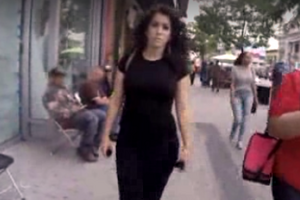Catcall video reaction: Is 'hello' in the street sexual harassment?
Critics of the New York City catcall video say that 'hello' and other greetings are not really harassment. Others say the video is racist. What do you think?

Hollaback YouTube
Is "hello" harassment?
Rob Bliss, creator of the viral video documenting the verbal harassment a woman encountered walking through the streets of Manhattan for a day, says "yes."
Some are hailing the video – which claims this woman was catcalled or otherwise harassed 108 times in a 10-hour span – as an exposé on a serious social scourge. But others are criticizing the video's assumptions, such as that a man greeting a woman on the street is harassment.
Bliss, who has a video marketing agency, admits that some of the scenes are more mild than others, but that "hello," in these situations, is definitely harassment.
"To annoy persistently: to create an unpleasant or hostile situation, especially by uninvited and unwelcome verbal or physical conduct," is the Merriam-Webster definition of the word.
Bliss continues that the criticisms of the video are mostly from men "missing the forest for the trees," he says.
"They don't understand the issue. They only see their own interaction with it and are missing out on the larger picture," he says. And context is key.
"Let's be clear. We're in New York City and guys don't just start up conversation," he says.
"This isn't your grandpa. These guys have motives."
And even if a single "hello" is relatively innocent, he says, it's about the collective weight – "of multiple guys on a block, it's all of them together commenting on your look, telling you to smile, day in and day out."
Shoshana Roberts, the woman who volunteered to be filmed for Hollaback!, a nonprofit working to end street harassment, is now receiving rape threats.
The nonprofit called these threats "unacceptable but sadly unsurprising."
"When women are visible in online or offline spaces, they experience harassment. When women demand change, they meet violent demands for their silence. We understand that violence exists on a spectrum that is played out on the street and online. We understand that it needs to change," it said in a statement on its website. "We hope that you will work with us to end street harassment and to fight harassment wherever it is found."
Others have criticized the video for being racist, as most of the two-minute clip depicts black and Latino men interacting with Roberts.
Bliss says it's inaccurate to look at the video as a survey.
"This is just Shoshana's single 10-hour experience. We didn't film for days and days going over every inch of the city," he says. "This is just a sample size."
He said two men of color "hold a lot sway in the running time of the video for stalking" Roberts, but that seven of the 18 scenes in the video include white men. That's roughly 40 percent, and New York City demographics put white people at about 44 percent of the population, he says.
"We know this extends to people of all backgrounds," Bliss says.
Still, social media and Internet comment sections are crowded with criticism.
But the goal was to capture what street harassment "really looked like without messaging or branding, or casting judgment – literally just capture it and lay it out bare for people to view and talk about it," says Bliss.
For women, Bliss says, he wanted them to be able to watch harassment when they weren't the subject.
"For men, the goal was to show what it looks like and hopefully also what it feels like," he says.


